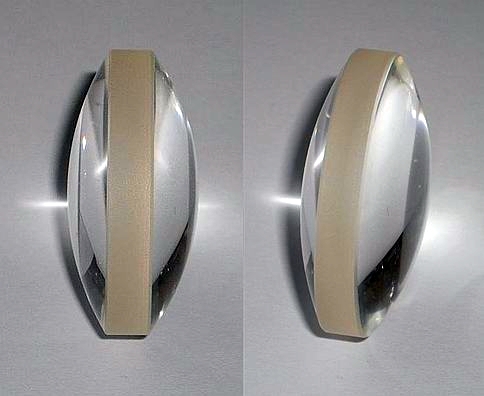Hello ladies and gents this is the viking telling you that today we are talking about

LENS
A lens is a transmissive optical device that focuses or disperses a light beam by means of refraction. A simple lens consists of a single piece of transparent material, while a compound lens consists of several simple lenses (elements), usually arranged along a common axis. Lenses are made from materials such as glass or plastic, and are ground and polished or molded to a desired shape. A lens can focus light to form an image, unlike a prism, which refracts light without focusing. Devices that similarly focus or disperse waves and radiation other than visible light are also called lenses, such as microwave lenses, electron lenses, acoustic lenses, or explosive lenses.
The word lens comes from lēns, the Latin name of the lentil, because a double-convex lens is lentil-shaped. The lentil plant also gives its name to a geometric figure.
Some scholars argue that the archeological evidence indicates that there was widespread use of lenses in antiquity, spanning several millennia. The so-called Nimrud lens is a rock crystal artifact dated to the 7th century BC which may or may not have been used as a magnifying glass, or a burning glass.[3][4][5] Others have suggested that certain Egyptian hieroglyphs depict "simple glass meniscal lenses".[6][verification needed]
The oldest certain reference to the use of lenses is from Aristophanes' play The Clouds (424 BC) mentioning a burning-glass.[7] Pliny the Elder (1st century) confirms that burning-glasses were known in the Roman period.[8] Pliny also has the earliest known reference to the use of a corrective lens when he mentions that Nero was said to watch the gladiatorial games using an emerald (presumably concave to correct for nearsightedness, though the reference is vague).[9] Both Pliny and Seneca the Younger (3 BC–65 AD) described the magnifying effect of a glass globe filled with water.
Ptolemy (2nd century) wrote a book on Optics, which however survives only in the Latin translation of an incomplete and very poor Arabic translation. The book was, however, received, by medieval scholars in the Islamic world, and commented upon by Ibn Sahl (10th century), who was in turn improved upon by Alhazen (Book of Optics, 11th century).
The Arabic translation of Ptolemy's Optics became available in Latin translation in the 12th century (Eugenius of Palermo 1154). Between the 11th and 13th century "reading stones" were invented. These were primitive plano-convex lenses initially made by cutting a glass sphere in half. The medieval (11th or 12th century) rock crystal Visby lenses may or may not have been intended for use as burning glasses.
Spectacles were invented as an improvement of the "reading stones" of the high medieval period in Northern Italy in the second half of the 13th century. This was the start of the optical industry of grinding and polishing lenses for spectacles, first in Venice and Florence in the late 13th century, and later in the spectacle-making centres in both the Netherlands and Germany.
Spectacle makers created improved types of lenses for the correction of vision based more on empirical knowledge gained from observing the effects of the lenses (probably without the knowledge of the rudimentary optical theory of the day). The practical development and experimentation with lenses led to the invention of the compound optical microscope around 1595, and the refracting telescope in 1608, both of which appeared in the spectacle-making centres in the Netherlands.
With the invention of the telescope and microscope there was a great deal of experimentation with lens shapes in the 17th and early 18th centuries by those trying to correct chromatic errors seen in lenses. Opticians tried to construct lenses of varying forms of curvature, wrongly assuming errors arose from defects in the spherical figure of their surfaces. Optical theory on refraction and experimentation was showing no single-element lens could bring all colours to a focus. This led to the invention of the compound achromatic lens by Chester Moore Hall in England in 1733, an invention also claimed by fellow Englishman John Dollond in a 1758 patent.
Comments
Post a Comment